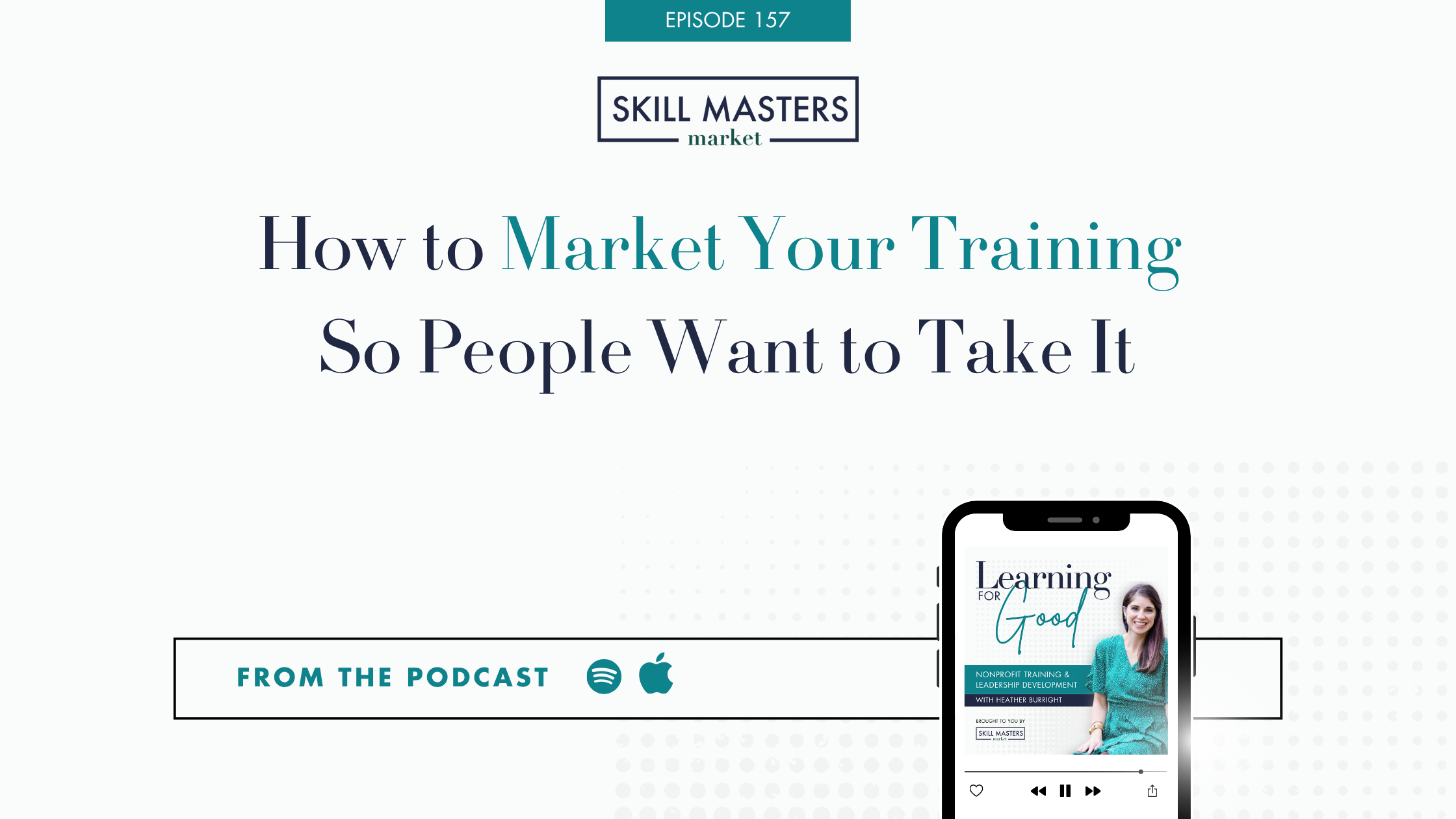How to Market Your Training So People Want to Take It
Have you ever created a training only to launch it into the world and be met with crickets?
I see this happen often in learning and development. However, I know how hard you work, and I know you're doing good, meaningful work in the nonprofit sector, so I don't want you to release a learning experience and be met with silence.
That's why, in this episode, I'm joined by Hannah Clark, Marketing for Learning® expert and strategist, and podcast host. We talk about how you can avoid that silence and how you can create and market your learning so it really resonates with your audience and has the impact it's intended to make.
▶️ Key Points:
03:16 Hannah's love for marketing and how she fell into the L&D niche
07:39 Why learning experiences fail or fall flat
10:02 How to make sure you create learning that resonates
17:14 What to do to get your learning experience in front of learners
24:27 Copywriting and design: how to use these crucial marketing tactics
28:38 Simple tips for when marketing feels overwhelming
A Typical Training Launch
What typically happens when you finish a new learning experience?
You’re proud of it—it’s thoughtful, mission-aligned, and designed to build real capability. You load it into your LMS. You hit publish.
And then… silence.
No sign-ups. No excitement. Just the echo of your hard work disappearing into the void.
It’s a story many nonprofit learning and development pros know too well.
In episode 157 of Learning for Good, I sit down with Hannah Clark, Marketing for Learning® strategist and podcast host, to talk about how to change that story.
Why Training Teams Need Marketing Skills
“Most learning teams focus all their energy on creating great content. But if no one knows it exists, it doesn’t matter how great it is. The shift is realizing that marketing isn’t an afterthought—it’s part of learning design.” - Hannah Clark
That’s the missing link for so many nonprofits.
We pour our expertise into developing the right learning solution—carefully planned, expertly facilitated, perfectly aligned to the mission—but then we skip the final step: helping people understand why it matters.
Marketing your learning isn’t just about “selling” it (though I know many of you do offer training as a revenue stream). It’s about connecting it—to the learner, to the work, and to the mission.
How to Approach Marketing in Learning & Development
Learning teams often focus on content creation first and promotion last, but Hannah shares that marketing should be baked into the learning design process from the start. It’s how we can go from compliance or “check the box” or mandated training to something that actually appeals to learners. Messaging should be emotional and mission-driven: “Here’s how this helps you do your work better and make a bigger impact.”
This means we might need to shift from communications that are stale - transactional email reminders, calendar invites, or course descriptions - to communications that celebrate the impact they will make.
When learning teams make that shift, engagement changes overnight. People don’t just sign up; they show up.
Marketing Tips for Nonprofit Training Teams
You don’t need to be a communications expert to get results. Hannah shared a few simple strategies that any nonprofit learning team can use:
Tell a Story.
Frame the learning around a problem your people care about solving. Show them the “before and after” your training can deliver.Make It Visual.
Use strong visuals, icons, or simple branding that make your learning recognizable—so it stands out in inboxes and meetings.Use Their Language.
Write copy that sounds like them, not you. Instead of “Increase knowledge retention,” try “Make meetings more productive.”Leverage Champions.
Ask respected leaders or peers to share why this learning mattered to them. Word-of-mouth builds credibility faster than any email ever could.Connect to their Desire or the Mission.
Tie every learning experience back to how it helps your nonprofit make a bigger impact, or how it helps them achieve their goals. That’s what keeps participation high.
Nonprofits often invest in training because they want better performance and stronger teams. But if staff don’t see how the learning connects to their daily work or to the mission, they won’t prioritize it.
That’s why messaging matters. When training is positioned as part of the mission, engagement isn’t something you have to chase; it happens naturally.
As Hannah put it:
“People don’t engage with learning because it’s mandatory. They engage because it speaks to something they care about.”
So the next time you start a learning initiative, ask:
What is the story of why this matters?
How can we connect it to what people already care about?
How can we make it easy for staff to see themselves in the learning?
Marketing your learning is the bridge between your strategy and the change you’re trying to create.
To learn more about marketing your training initiatives, tune into episode 157 of the Learning for Good podcast.
Additional Resources Just for You
Other Helpful Podcast Episodes:
Subscribe to the Nonprofit L&D Insiders.
Join the Nonprofit L&D Collective.
Support the Learning for Good Podcast
Become a sponsor.
Ask a question or suggest a topic.
We love hearing from listeners!
Leave a review.
Reviews teach us what content resonates most and help us reach more people!

